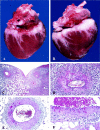Endothelin receptor subtype distribution predisposes coronary arteries to damage
- PMID: 10880383
- PMCID: PMC1850223
- DOI: 10.1016/S0002-9440(10)64524-5
Endothelin receptor subtype distribution predisposes coronary arteries to damage
Abstract
Several vasoactive drugs that lower blood pressure and increase heart rate induce regional cardiotoxicity in the dog, most frequently of right coronary arteries and right atrium. The basis for this selective damage is thought to result from local changes in vascular tone and blood flow. Administration of an endothelin receptor antagonist (ETRA, SB 209670) to dogs induced damage most frequent and severe in the right coronary artery and right atrium. Because site predisposition may correlate with distribution of vasoactive receptors, the objectives of this study were to map endothelin (ET) receptor distribution and density within regions of dog heart using both gene (mRNA) and protein expression endpoints for dog ET(A) and ET(B) receptors, and, additionally, correlate ET receptor subtype density with regional cardiac blood flow. A 10- to 15-mmHg reduction in mean arterial pressure with a concomitant increase in heart rate (10-20%), a six- and twofold increase in regional blood flow to the right and left atrium, respectively, and acute hemorrhage, medial necrosis, and inflammation were observed in the right coronary arteries and arteries of the right atrium after ETRA infusion for 5 days. Radioligand protein binding to quantify both ET receptors in normal dog heart indicated a twofold greater density of ET receptors in atrial regions versus ventricular regions. Importantly, ET receptor density in coronary arteries was markedly (about five- to sixfold) increased above that in atrial or ventricular tissues. ET receptor subtype characterization indicated ET(B) receptors were three times more prevalent in right coronary arteries compared to left coronary arteries and in situ hybridization confirmed localization of ET(B) in vascular smooth muscle. ET(A) receptor density was comparable in right and left coronary arteries. Quantitative real-time polymerase chain reaction for ET(A) and ET(B) receptor mRNA transcripts supported the site prevalence for message distribution. Consequently, the composite of protein and message expression profiles for ET(A) and ET(B) receptors indicated a disproportionate distribution of ET(B) receptors within right coronary artery of dog and this, along with functional measures of blood flow after ETRA infusion indicated a predisposition for exaggerated pharmacological responses and subsequent damage to right coronary arteries by ET and/or ETRAs.
Figures







Similar articles
-
Cellular localization of the endothelin receptor subtypes ET(A) and ET(B) in the rat heart and their differential expression in coronary arteries, veins, and capillaries.Histochem Cell Biol. 2002 Nov;118(5):361-9. doi: 10.1007/s00418-002-0457-4. Epub 2002 Oct 17. Histochem Cell Biol. 2002. PMID: 12432447
-
Contractile and arrhythmic effects of endothelin receptor agonists in human heart in vitro: blockade with SB 209670.J Pharmacol Exp Ther. 2000 Jan;292(1):449-59. J Pharmacol Exp Ther. 2000. PMID: 10604982
-
Coronary arterial lesions in dogs treated with an endothelin receptor antagonist.J Cardiovasc Pharmacol. 1998;31 Suppl 1:S384-5. doi: 10.1097/00005344-199800001-00109. J Cardiovasc Pharmacol. 1998. PMID: 9595490
-
Regulation of coronary blood flow during exercise.Physiol Rev. 2008 Jul;88(3):1009-86. doi: 10.1152/physrev.00045.2006. Physiol Rev. 2008. PMID: 18626066 Review.
-
Working under pressure: coronary arteries and the endothelin system.Am J Physiol Regul Integr Comp Physiol. 2010 May;298(5):R1188-94. doi: 10.1152/ajpregu.00653.2009. Epub 2010 Mar 17. Am J Physiol Regul Integr Comp Physiol. 2010. PMID: 20237301 Free PMC article. Review.
Cited by
-
Evaluation of von Willebrand factor and von Willebrand factor propeptide in models of vascular endothelial cell activation, perturbation, and/or injury.Toxicol Pathol. 2014 Jun;42(4):672-83. doi: 10.1177/0192623313518664. Epub 2014 Feb 4. Toxicol Pathol. 2014. PMID: 24499802 Free PMC article.
References
-
- Dogterom P, Zbinden G, Reznik GK: Cardiotoxicity of vasodilators and positive inotropic/vasodilating drugs in dogs: an overview. CRC Crit Rev Toxicol 1992, 22:203-241 - PubMed
-
- Gans JH, Korson R, Cates MR, Ackerly CC: Effects of short-term and long term theobromine administration to male dogs. Toxicol Appl Pharmacol 1980, 53:481-496 - PubMed
-
- Harlem JH, Joseph EC, Eden RJ, Walker TF, Major IR, Lamb MS: Cardiotoxicity of a new inotrope/vasodilator drug (SK&F 94120) in the dog. Arch Toxicol 1986, 59:51-55 - PubMed
-
- Herman EH, Balazs T, Young R, Earl FL, Krop S, Ferrans VJ: Acute cardiomyopathy induced by vasodilating antihypertensive agent minoxidil. Toxicol Appl Pharmacol 1979, 47:493-503 - PubMed
-
- Mesfin GM, Shawaryn GG, Higgins MJ: Cardiovascular alterations in dogs treated with hydralazine. Toxicol Pathol 1987, 15:409-416 - PubMed
MeSH terms
Substances
LinkOut - more resources
Full Text Sources

